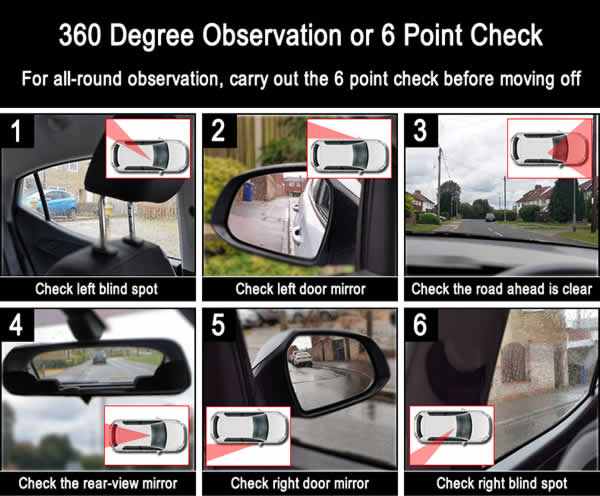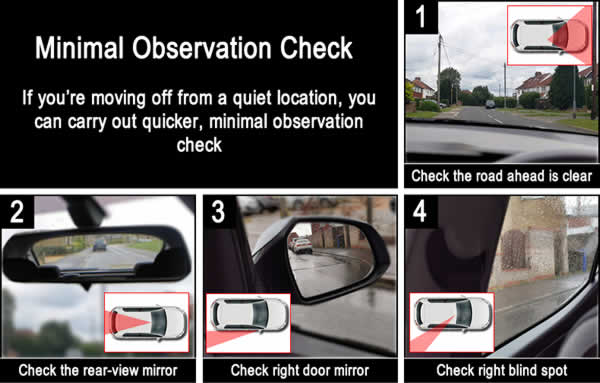During a driving test, examiners are very strict when it comes to safety observational checks such as mirrors and blind spots. Examiners are particularly thorough when it comes to safety checks when moving off from a parked position. This is because if the observational safety checks aren’t carried out properly, or at all, vulnerable road users such as pedestrians cyclists and motorcyclists can be injured.
Many driving tests are failed each year due to test candidates either not properly carrying out observational checks before moving off, or missing out a critical check. This guide explains the proper observational checks including mirrors and blind spots that must be done before moving off from parked position.
360 Degree, 6 Point check
The 6 point check is an all-round, 360 degree observational check that includes all of your vehicle’s mirrors and blind spots. You will generally carry out a 6 point check prior to moving off from a parked position at the side of the road.
While on a driving test, the examiner will ask that you park up on the left, only to move off again when ready. When doing so, the examiner is assessing your ability to move off safely and under control. The 360 degree observational check, or 6 point check requires looking into the:
- Left-side blind spot. Look over your left shoulder, through the rear-left window into the blind spot. Here, we’re looking for pedestrians on the pavement. Being aware of pedestrians, even on the pavement is important just in case they decide to cross the road.
- Left, passenger door mirror. Here, we’re looking down the road or on the pavement for cyclists. Look particularly for children, who may be difficult to see in other mirrors.
- Road ahead. Look ahead for any traffic that may be approaching. You can still move off if traffic is approaching from ahead, but what you’re looking for are potential hazards. For example, if a cyclist is coming towards you, a car may overtake the cyclist and by doing so, drive into your lane.
- Internal rear-view mirror. We look into the rear-view mirror for other road users such as vehicles, motorcyclists and cyclists. If it looks like we may not move off in good time before they reach us, wait until the pass.
- Right, driver’s door mirror. This allows us a wider view of the road behind.
- Right-side blind spot. Look over your right shoulder for cyclists and pedestrians crossing the road. When moving off from the left side of the road, checking the right blind spot is essential. Many candidates fail the driving test due to forgetting this simple check.

Minimal Observations Before Moving Off
With safety in mind, you should always know what’s going on all around your vehicle and when moving off, you can achieve that by using the 360 degree, 6 point check technique.
However, there is a minimal observation check that is also acceptable and is also a little quicker to carry out. You can use minimal observations if for instance, you’ve stopped in a quiet area. Minimal observations are the same as the full 360 degree check, you’re just missing out the first two stages:
- Check the road ahead is clear from hazards
- Look in your rear-view mirror for vehicles or approaching cyclists
- Look into the driver’s door mirror to check if there’s anything you didn’t see in the rear-view mirror
- Finally, look over your right shoulder into the blind spot

Repeating Observations if you get Interrupted
You may for example, be carrying out observations and half way through a pedestrian crosses the road in front of you, or a vehicle approaches from behind meaning you need to wait before the road is clear.
On our roads, things can change very quickly, so it’s important to do all of the observations again if you get interrupted. At the very least, perform minimal observations before moving the car off.
Moving Off from the Right-Side of the Road
The practical driving test includes a manoeuvre that involves you pulling on the right-side of the road, revering back one car’s length, then moving off. When moving off from the right-side of the road, carry out the same observations, except in reverse order. Start by looking over your right shoulder, working your way round the mirrors until you finish at the left blind spot.
How Long Should it Take to Carry Out Observations Before Moving Off?
When you’re starting out learning to drive, everything takes time to learn and that includes carrying out safety observation checks. If you take too long with observations before moving off on a busy road, you’ll never move off before another car comes.
You need to aim to look into all the observation areas as quickly as you can while also acknowledging what’s there and also understanding how to appropriately deal with what you see.
This does of course take time and practice to make this process quick, but there’s little point in looking in your mirrors if you’re not really seeing what’s going on in them. It can also be difficult to gauge how far away a vehicle or cyclist is when looking in mirrors. This will get easier and quicker with more practice.
Moving Off in an Automatic Car
If you’re starting out learning to drive and want to learn how to move off from a parked position, read how instructor’s do it by following the moving off in an automatic car tutorial.